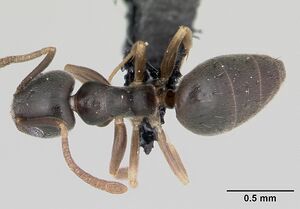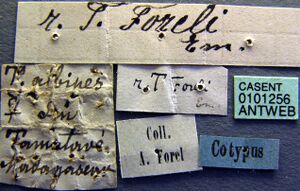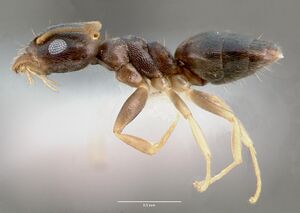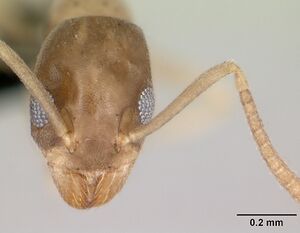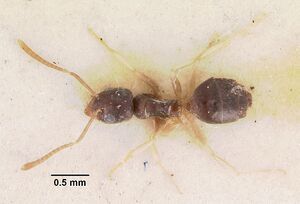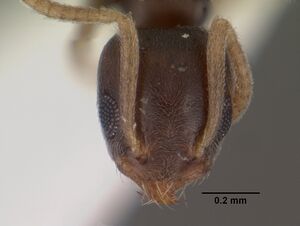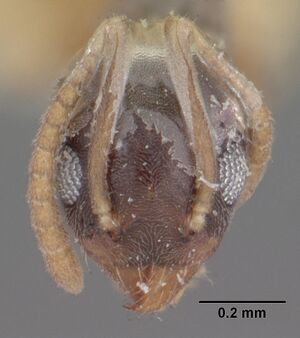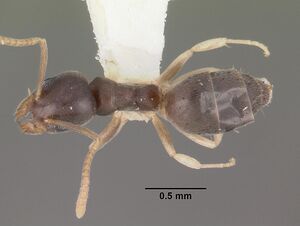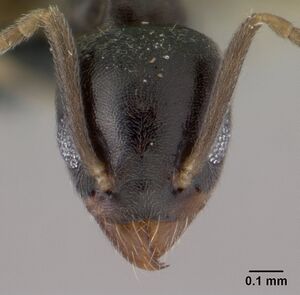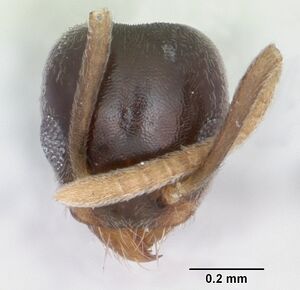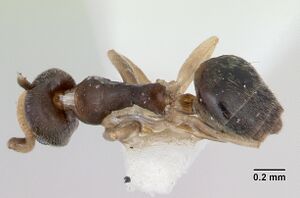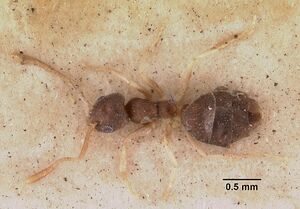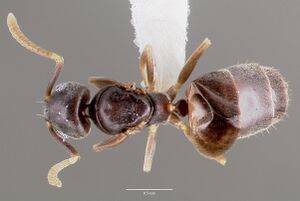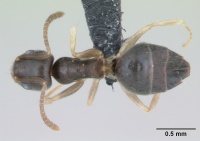T. pallipes is a common and very widely distributed species in the Afrotropical and Malagasy regions, and is present as an introduction on the Atlantic islands off Africa. It has also been recorded from hothouses, and once from a dwelling, in the West Palaearctic. Nest sites appear opportunistic, being constructed in the ground under stones, in or under rotten wood, under the bark of living trees, in rotten parts of standing trees and in hollow stems and twigs of plants. The species efficiently colonises areas disturbed by human activities and may be prevalent in plantations of tree and shrub crops. In Madagascar it is common in parks and gardens and in South Africa it is known to invade houses, where it may nest in bizarre locations such as electricity transformers or light fixtures. In other countries it has been recorded as entering houses in search of sugary food or water. Foraging is carried out both terrestrially and arboreally. When foraging on shrubs and trees pallipes tends a wide range of homopterous insects. The species called albipes in Samways, Nell & Prins (1982), associated with outbreaks of red scale on citrus in South Africa, is most probably pallipes, as also is the species referred to as albipes by Prins, Robertson & Prins (1990) In their synopsis of pest ants of South Africa. (Bolton 2007)
Identification
Bolton (2007) - A member of the T. pallipes complex in the Technomyrmex albipes group. The arrangement of setae and their relative lengths is characteristic of this small but relatively large-eyed species. A similar arrangement is seen only in the closely related Technomyrmex vapidus of Kenya and Tanzama, but that species is larger, brightly coloured, and has more posteriorly located eyes.
A series of intercastes is present between worker and queen in which 0, 1 or 3 ocelli are developed and the mesosoma gradually increases in size and complexity. The mesonotum gradually differentiates into mesoscutum and mesoscutellum and in larger individuals a small prominent metanotum is also developed. Ergatoid males are produced as well as alate males and queens.
Keys including this Species
Distribution
This species is of Afrotropical origin and has been introduced to the Palaearctic, Nearctic, Indo-Malayan and Australian regions (Bolton, 2007; Guénard et al., 2017). In the Canary Islands, it has reported for just one single locality of Gran Canaria (Hernandez-Teixidor et al., 2020).
Latitudinal Distribution Pattern
Latitudinal Range: 15.093339° to -34.1978923°.
Afrotropical Region: Angola, Central African Republic, Comoros, Gambia, Kenya, Mozambique, Rwanda, Sudan, United Republic of Tanzania.
Malagasy Region: Madagascar, Mauritius (type locality), Mayotte, Réunion, Seychelles.
Palaearctic Region: Italy.
Distribution based on AntMaps
Distribution based on AntWeb specimens
Check data from AntWeb
Countries Occupied
| Number of countries occupied by this species based on AntWiki Regional Taxon Lists. In general, fewer countries occupied indicates a narrower range, while more countries indicates a more widespread species.
|

|
Estimated Abundance
| Relative abundance based on number of AntMaps records per species (this species within the purple bar). Fewer records (to the left) indicates a less abundant/encountered species while more records (to the right) indicates more abundant/encountered species.
|

|
Biology
In its introduced range, this species is found in greenhouses and houses (Wetterer, Espadaler, Wetterer, Aguin-Pombo, & Franquinho-Aguiar, 2007), but it is also common in outdoor areas such as parks and gardens in warmer countries (Bolton, 2007). Moreover, it has been reported as an occasional locally serious pest in citrus orchards (Bolton, 2007; Samways, Nel, & Prins, 1982). Although no major negative impacts have been reported to date, it could act as invasive such as other species of this genus like T. albipes (Hernandez-Teixidor et al., 2020).
Castes
Worker
Queen
Male
Nomenclature
The following information is derived from Barry Bolton's Online Catalogue of the Ants of the World.
- pallipes. Tapinoma pallipes Smith, F. 1876a: 447 (w.) MAURITIUS (Rodrigues I.). [Misspelled as pallidipes by Dalla Torre, 1893: 166.] Combination in Technomyrmex: Bolton, 2007a: 56. Senior synonym of affinis, atrichosus, brevicornis, foreli, primroseae, truncicolus: Bolton, 2007a: 56.
- foreli. Technomyrmex albipes subsp. foreli Emery, 1893f: 249 (w.) MADAGASCAR. Forel, 1910e: 446 (q.m.). Raised to species: Santschi, 1930a: 70. Junior synonym of pallipes: Bolton, 2007a: 56.
- atrichosus. Technomyrmex atrichosus Viehmeyer, 1922: 214 (w.) KENYA. Junior synonym of pallipes: Bolton, 2007a: 56.
- affinis. Technomyrmex foreli var. affinis Santschi, 1930a: 71 (w.) KENYA. [First available use of Technomyrmex albipes st. foreli var. affinis Santschi, 1914b: 119; unavailable name.] Junior synonym of pallipes: Bolton, 2007a: 56.
- brevicornis. Technomyrmex brevicornis Santschi, 1930a: 71, figs. 34-36 (w.) ANGOLA. Junior synonym of pallipes: Bolton, 2007a: 56.
- truncicolus. Technomyrmex albipes subsp. truncicolus Weber, 1943c: 380 (w.) SUDAN. Junior synonym of pallipes: Bolton, 2007a: 56.
- primroseae. Technomyrmex primroseae Donisthorpe, 1949e: 273 (w.) MAURITIUS. Junior synonym of pallipes: Bolton, 2007a: 57.
Unless otherwise noted the text for the remainder of this section is reported from the publication that includes the original description.
Description
Worker
Bolton (2007) - TL 2.3 - 2.8, HL 0.52 - 0.68, HW 0.46 - 0.64, SL 0.45 - 0.64, PW 0.33 - 0.37, WL 0.65 - 0.72 (30 measured). Indices: CI 84 - 94, SI 92 - 106, or 28 - 33, EPI 55 - 71, DTI 120 - 128.
Frontal carina with 2 setae: in profile the anterior above the torulus, the posterior at the level of the anterior portion of the eye; both of these shorter than the maximum diameter of the eye. No seta present at level of posterior margin of eye. Posterior to this the dorsum with 2 pairs of inconspicuous, extremely short stubbly setae, both of which are less than half the length of the seta above the eye: anterior pair about midway between level of posterior margin of eye and posterior margin of head, posterior pair very close to or at the posterior margin (easily abraded). In full-face view median portion of anterior c1ypeal margin extremely shallowly concave or feebly indented; posterior margin of head at most very slightly concave or impressed medially, sometimes almost transverse. Eyes relatively large and located in front of midlength, EPI < 80; in full-face view outer margins of eyes touch, or more usually break, the outline of the sides. Number of setal pairs on dorsal mesosoma: pronotum 1 - 3, shorter than maximum diameter of eye; mesonotum 1, about half the length of the pronotal setae and located at the point where the slope of the mesonotal dorsum changes; propodeal dorsum 0; lateral margins of propodeal declivity 2 (rarely 3), above the level of the spiracle. With mesosoma in profile the posterior one-third of the mesonotum is more steeply sloped than the anterior two-thirds. Metanotal groove distinct but only shallowly impressed. Dorsum of propodeum short and more or less flat, meeting the steeply sloped declivity in a blunted angle. Gastral tergites 1 - 4 each with numerous setae, distributed everywhere on the sclerites; usually all are distinctly shorter than the maximum diameter of the eye. Head, mesosoma and gaster uniformly light brown to uniformly black, with all shades attested between these extremes; sometimes the gaster is slightly darker than the mesosoma. Legs lighter than head and body, varying from pale yellow to dull brownish yellow. Tibiae and tarsi are always the same colour, the former never considerably darker than the latter; femora may be somewhat darker, in whole or in part, than the tibiae.
Type Material
Bolton (2007) - Syntype workers, Rodriguez I. (The Natural History Museum) [examined].
References
- Blard, F., Dorow, W.-H.-O., Delabie, J. H. C. 2003. Les Fourmis de l’île de la Réunion (Hymenoptera, Formicidae). Bulletin de La Société Entomologique de France, 108(2), 127–137 (doi:10.3406/bsef.2003.16939).
- Bolton, B. 2007. Taxonomy of the dolichoderine ant genus Technomyrmex Mayr (Hymenoptera: Formicidae) based on the worker caste. Contributions of the American Entomological Institute. 35(1):1-149.
- Borowiec, L., Salata, S. 2018. Notes on ants (Hymenoptera: Formicidae) from Gambia (Western Africa). Annals of the Upper Silesian Museum in Bytom, Entomology 26 (online 010), 1-13 (doi:10.5281/ZENODO.1243767).
- Cantone S. 2018. Winged Ants, The queen. Dichotomous key to genera of winged female ants in the World. The Wings of Ants: morphological and systematic relationships (self-published).
- Dekoninck, W., Wauters, N., Delsinne, T. 2019. Capitulo 35. Hormigas invasoras en Colombia. Hormigas de Colombia.
- Guillem, R., Bensusan, K. 2022. Thee new exotic species of ants (Hymenoptera, Formicidae) for Madeira, with comments on its myrmecofauna. Journal of Hymenoptera Research 91: 321–333 (doi:10.3897/jhr.91.81624).
- Hernández-Teixidor, D., Pérez-Delgado, A.J., Daniel Suárez, D., Reyes-López, J. 2020. Six new non-native ants (Formicidae) in the Canary Islands and their possible impacts. Journal of Applied Entomology 00:1–8 (doi:10.1111/jen.12751).
- Molfini, M., Zapparoli, M., Genovesi, P., Carnevali, L., Audisio, P., Di Giulio, A., Bologna, M.A. 2020. A preliminary prioritized list of Italian alien terrestrial invertebrate species. Biological Invasions 22(8), 2385–2399 (doi:10.1007/s10530-020-02274-w).
- Nsengimana, V., Hagenimana, T., Barakagwira, J., de Dieu Nsenganeza, J., Iradukunda, S. C., Majyambere, M., Kizungu, O. B., Nkundimana, A., Umutoni, D., Fabrice, R., Cyubahiro, B., Kouakou, L. M., Kolo, Y., Anale, J. S., Gómez, K., Dekoninck, W. 2023. Checklist of ant (Hymenoptera: Formicidae) species from Nyungwe Tropical Rain Forest, south-western Rwanda. Journal of East African Natural History 111(2), 69-81 (doi:10.2982/028.111.0203).
- Pech, P., Bezděk, A. 2016. Ergatomorph wingless males in Technomyrmex vitiensis Mann, 1921 (Hymenoptera: Formicidae). Journal of Hymenoptera Research 53, 25–34 (doi:10.3897/jhr.53.8904).
- Schifani, E. (2022). The new checklist of the Italian fauna: Formicidae. Biogeographia – The Journal of Integrative Biogeography 37, ucl006 (doi:10.21426/b637155803).
- Baroni Urbani C. 1977. Katalog der Typen von Formicidae (Hymenoptera) der Sammlung des Naturhistorischen Museums Basel (2. Teil). Mitt. Entomol. Ges. Basel (n.s.) 27: 61-102.
- Bolton B. 2007. Taxonomy of the dolichoderine ant genus Technomyrmex Mayr (Hymenoptera: Formicidae) based on the worker caste. Contributions of the American Entomological Institute 35(1): 1-150.
- Bolton, B. "Taxonomy of the dolichoderine ant genus Technomyrmex Mayr (Hymenoptera: Formicidae) based on the worker caste." Contributions of the American Entomological Institute 35, no. 1 (2007): 1-149.
- Borowiec L., and S. Salata. 2018. Notes on ants (Hymenoptera: Formicidae) from Gambia (Western Africa). Annals of the Upper Silesian Museum in Bytom Entomology 26: 1-13.
- Forel A. 1910. Note sur quelques fourmis d'Afrique. Annales de la Société Entomologique de Belgique 54: 421-458.
- Forel A. 1913. Ameisen aus Rhodesia, Kapland usw. (Hym.) gesammelt von Herrn G. Arnold, Dr. H. Brauns und Anderen. Deutsche Entomologische Zeitschrift 1913(Suppl.): 203-225.
- Hita Garcia F., E. Wiesel, G. Fischer. 2013. The ants of Kenya (Hymenoptera: Formicidae)faunal overview, first species checklist, bibliography, accounts for all genera, and discussion on taxonomy and zoogeography. Journal of East African Natural History 101: 127-222.
- IZIKO South Africa Museum Collection
- Magagula C. N., and B. A. Nzimba. 2015. Interaction between habitat characteristics and insect diversity using ground beetles (Colenoptera: Carabidae) and ants (Hymenoptera: Formicidae) within a variety of agriculatural habitats. Applied Ecology and Environmental Research 13(3): 863-876.
- Prins A. J. 1963. A list of the ants collected in the Kruger National Park with notes on their distribution. Koedoe 6: 91-108.
- Prins A. J. 1964. Revised list of the ants collected in the Kruger National Park. Koedoe 7: 77-93.
- Prins A. J., and J. J. Cillie. 1968. The ants collected in the Hluhluwe and Umfolozi game reserves. The Lammergeyer 8: 40-47.
- Santschi F. 1914. Formicides de l'Afrique occidentale et australe du voyage de Mr. le Professeur F. Silvestri. Bollettino del Laboratorio di Zoologia Generale e Agraria della Reale Scuola Superiore d'Agricoltura. Portici 8: 309-385.
- Santschi F. 1930. Description de Formicides éthiopiens nouveaux ou peu connus. V. Bulletin et Annales de la Société Entomologique de Belgique 70: 49-77.
- Santschi F. 1937. Résultats de la Mission scientifique suisse en Angola (2me voyage) 1932-1933. Fourmis angolaises. Revue Suisse de Zoologie. 44: 211-250.
- Shattuck S. O. 1994. Taxonomic catalog of the ant subfamilies Aneuretinae and Dolichoderinae (Hymenoptera: Formicidae). University of California Publications in Entomology 112: i-xix, 1-241.
- Weber N. A. 1943. The ants of the Imatong Mountains, Anglo-Egyptian Sudan. Bulletin of the Museum of Comparative Zoology 93: 263-389.
- Wetterer J. K., X. Espadaler, A. L. Wetterer, D. Aguin-Pombo, and A. M. Franquinho-Aguiar. 2007. Ants (Hymenoptera: Formicidae) of the Madeiran archipelago. Sociobiology 49: 265-297.
- Wheeler W. M. 1922. Ants of the American Museum Congo expedition. A contribution to the myrmecology of Africa. VIII. A synonymic list of the ants of the Ethiopian region. Bulletin of the American Museum of Natural History 45: 711-1004
- Wild A. L. 2009. Evolution of the Neotropical ant genus Linepithema. Systematic Entomology 34: 49-62









